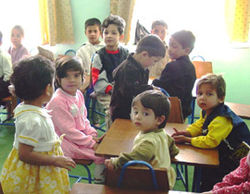Introduction to Sociology / Socialization
Goals of Socialization
Arnett,[1] in presenting a new theoretical understanding of socialization (see below), outlined what he believes to be the three goals of socialization:- impulse control and the development of a conscience
- role preparation and performance, including occupational roles, gender roles, and roles in institutions such as marriage and parenthood
- the cultivation of sources of meaning, or what is important, valued, and to be lived for
It should also be noted that, while socialization is a key sociological process in the development of individuals who can function in human society, not every aspect of human behavior is learned. For instance, there is evidence that most children have innate empathy for individuals who are wilfully injured and consider it wrong. Thus, some aspects of human behavior that one might believe are learned, like empathy and morals, may, in fact, be biologically determined. To what extent human behavior is biologically determined vs. learned is still an open question in the study of human behavior, but recent reviews of biological, genetic, neuroscience, and psychological literatures suggest that culture can influence biology and vice versa (e.g., nurture becomes nature through processes wherein learned responses and behaviors feed the development of the brain and the activation of genetic potential)
Primary and Secondary Socialization
Socialization is a life process, but is generally divided into two parts: Primary socialization takes place early in life, as a child and adolescent. Secondary socialization refers to the socialization that takes place throughout one's life, both as a child and as one encounters new groups that require additional socialization. While there are scholars who argue that only one or the other of these occurs, most social scientists tend to combine the two, arguing that the basic or core identity of the individual develops during primary socialization, with more specific changes occurring later - secondary socialization - in response to the acquisition of new group memberships and roles and differently structured social situations. The need for later life socialization may stem from the increasing complexity of society with its corresponding increase in varied roles and responsibilities.Mortimer and Simmons outline three specific ways these two parts of socialization differ:
- content - Socialization in childhood is thought to be concerned with the regulation of biological drives. In adolescence, socialization is concerned with the development of overarching values and the self-image. In adulthood, socialization involves more overt and specific norms and behaviors, such as those related to the work role as well as more superficial personality features.
- context - In earlier periods, the socializee (the person being socialized) more clearly assumes the status of learner within the context of the initial setting (which may be a family of orientation, an orphanage, a period of homelessness, or any other initial social groups at the beginning of a child's life), the school (or other educational context), or the peer group. Also, relationships in the earlier period are more likely to be affectively charged, i.e., highly emotional. In adulthood, though the socializee takes the role of student at times, much socialization occurs after the socializee has assumed full incumbency of the adult role. There is also a greater likelihood of more formal relationships due to situational contexts (e.g., work environment), which moderates down the affective component.
- response - The child and adolescent may be more easily malleable than the adult. Also, much adult socialization is self-initiated and voluntary; adults can leave or terminate the process at any time if they have the proper resources (symbolic, financial, and social) to do so.
Broad and Narrow Socialization
Arnett proposed an interesting though seldom used distinction in types of socialization. Arnett distinguishes between broad and narrow socialization:- broad socialization is intended to promote independence, individualism, and self-expression; it is dubbed broad because this type of socialization has the potential of resulting in a broad range of outcomes
- narrow socialization is intended to promote obedience and conformity; it is dubbed narrow because there is a narrow range of outcomes
- the whole process by which an individual born with behavioral potentialities of enormously wide range, is led to develop actual behavior which is confined with a much narrower range; the range of what is customary and acceptable for him according to the standards of his group

No comments:
Post a Comment